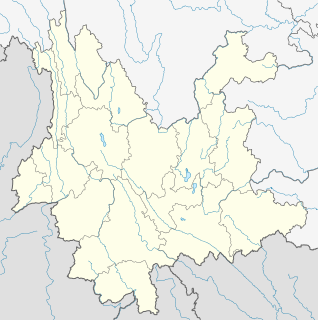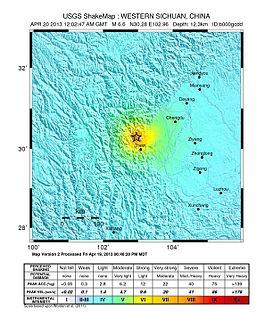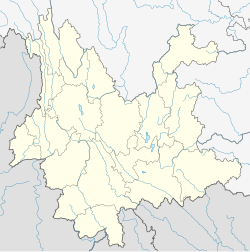
The 2008 Panzhihua earthquake struck southern Sichuan province, China on August 30 at with a surface wave magnitude of 6.1. It is also cited as the Renhe-Huili earthquake, especially in SCEA reports and early CEA reports. It was not an aftershock of the Sichuan earthquake that occurred several months prior. With more than 400 aftershocks, it caused over 40 deaths, the collapse of 10,000 homes and damage to other infrastructure in the area. The maximum intensity was VIII liedu.

The 2008 Yingjiang earthquakes were a series of major earthquakes ranging from surface wave magnitude (Ms) 4.1 to 5.9 that struck Yingjiang County, Yunnan province, China between August 19 and September 3. It caused 5 deaths, 21 serious injuries, and RMB 2.7 billion in direct economic damage. USGS put the magnitude of the strongest one to Mw 6.0.

Ludian County is a county under the administration of the prefecture-level city of Zhaotong, it lies in the north east of Yunnan Province, China, and shares land borders with Guizhou Province. The west and east of the county are high terrains, and the middle is low and flat. Agriculture and smelting industry make the greatest contribution to its economy.
The 2010 Yushu earthquake struck on April 14 and registered a magnitude of 6.9 Mw or 7.1 Ms. It had a maximum felt intensity of IX (Violent) on the Mercalli intensity scale. It originated in Yushu, Qinghai, China, at 7:49 am local time. According to the Xinhua News Agency, 2,698 people were confirmed dead, 270 missing and 12,135 injured, 1,434 of them severely. The epicenter was located in Rima village (日玛村/日麻村), Upper Laxiu township (上拉秀乡) of Yushu County, in remote and rugged terrain, near the border of Tibet Autonomous Region, about 30 km from Gyêgu town or Jyekundo, the seat of Yushu County, and about 240 km from Qamdo. The epicenter was in a sparsely populated area on the Tibetan plateau that is regularly hit by earthquakes.
Sani is one of the Loloish languages spoken by the Yi people of China. It is one of six Yi languages recognized by the Chinese government, under the name Southeastern Yi. Sani is spoken in Shilin, Luliang, Luxi, Shizong, Yiliang, Malong, Luquan, and Mile counties by about 120,000 speakers.

The 1998 Ninglang earthquake (1998年宁蒗地震) occurred on November 19 at . The epicenter was near the border between the provinces of Sichuan and Yunnan, China. The United States Geological Survey stated that the epicenter was located in the Sichuan Province, while the China Earthquake Data Center provided a different location in Lanniqing Township (烂泥箐乡), Ninglang, Yunnan Province. The magnitude of the earthquake was put at 6.2 and it caused five deaths, with 208 seriously injured in Yunnan and 20 people seriously injured in Sichuan. Building damage was reported in Ninglang, Yunnan and Yanyuan, Sichuan. A dammed lake was formed by a landslide in the Lanniqing Township.

The Lushan earthquake or Ya'an earthquake occurred at 08:02 Beijing Time on April 20, 2013. The epicenter was located in Lushan County, Ya'an, Sichuan, about 116 km (72 mi) from Chengdu along the Longmenshan Fault in the same province heavily impacted by the 2008 Sichuan earthquake. The magnitude of the earthquake was placed at Ms 7.0 by China Earthquake Data Center, Ms 7.0 by Russian Academy of Sciences, Mw 7.0 by Geoscience Australia, Mw 6.6 by the United States Geological Survey (USGS), Mw 6.6 by the European Alert System (EMSC) and Mj 6.9 by the Japan Meteorological Agency (JMA). 1,815 aftershocks have been recorded as of 00:00 (UTC+8h) April 22.

The 2014 Ludian earthquake struck Ludian County, Yunnan, China, with a moment magnitude of 6.1 on 3 August. The earthquake killed at least 617 people, injuring at least 2,400 others. As of 5 August 2014, 112 people remain missing. Over 12,000 houses collapsed and 30,000 were damaged. According to the United States Geological Survey, the earthquake occurred 29 km (18 mi) WSW of Zhaotong city at 16:03 local time (08:03 UTC).

The 2014 Jinggu earthquake occurred on October 7, 2014 at 21:49 (UTC+8).

The 2014 Kangding earthquake struck Kangding County, Garzê Tibetan Autonomous Prefecture, Sichuan, China, with a moment magnitude of 5.9 on 22 November. The earthquake killed five and injured 54 people.
Chengdu–Lanzhou railway is a Chinese railway line under construction, connecting Chengdu, the provincial capital of Sichuan with Lanzhou, capital of Gansu, with a branch connecting Chengdu to Xining, the capital of Qinghai. The line was planned and approved in the aftermath of the 2008 Sichuan earthquake, in order to improve future transportation in the affected area, through which the line will pass directly.

The Lanzhou–Xinjiang high-speed railway, also known as Lanzhou–Xinjiang Passenger Railway or Lanxin Second Railway, is a high-speed railroad in Northwestern China from Lanzhou in Gansu Province to Ürümqi in the Xinjiang Uyghur Autonomous Region. It forms part of what China designates the Eurasia Continental Bridge corridor, a domestic high-speed railway corridor running from its city of Lianyungang to the Kazakh border.
Chen Qiang is a former military officer in the Chinese People's Liberation Army. He attained the rank of major general in July 2010. He graduated from PLA National Defense University. He once served as Deputy Commander of 96351 Unit of the Second Artillery Corps. During the 2008 Sichuan earthquake, he joined in the relief work. In May 2014, he was sentenced to life imprisonment for "corruption, bribery, huge amount of property with unidentified sources".

A landslide occurred at about 5:38 am local time on 24 June 2017 in Diexi Town, Mao County, Sichuan Province in south-western China. It destroyed 40 homes in Xinmo Village and killed 10 people, with a further 73 people missing, as of 27 June. A second smaller landslide at around 17:19 pm impeded rescue efforts.
The 2017 Jiuzhaigou earthquake occurred on 8 August 2017, in Zhangzha Town, Jiuzhaigou County, Ngawa Prefecture, Sichuan Province, China. The earthquake was registered at Ms 7.0 and killed at least 25 people in the mountainous region of northern Sichuan.

The 1976 Longling earthquake in Yunnan Province, People's Republic of China, was a doublet earthquake, with two main shocks striking just east of Longling at 12:23:20 and 14:00:22 UTC. The magnitudes were estimated at 6.7 and 6.6, respectively, on the (GCMT) scale, and 6.9 and 7.0 on the scale; Chinese sources put these at 7.4 and 7.3 on the scale. The region is noted for the quantity and intensity of its earthquakes, and the complexity of its tectonics, which are closely related to the collision between the Indian and Eurasian tectonic plates.

On May 21, 2021, a 6.1 magnitude earthquake strucked the Dali City, Yunnan, China, at a depth of 10.0 km. Three people died during the quake, while another 32 were injured. The earthquake was referred by the Chinese media as the 5.21 earthquake or 2021 Yangbi earthquake.
The 2021 Luxian earthquake was a damaging seismic event occurring in the early hours of September 16 at 04:33 China Standard Time. The surface wave magnitude (Ms ) 6.0 or moment magnitude (Mw ) 5.4 earthquake struck at a shallow depth of 7.5 km and was assigned a maximum intensity of VIII on the China seismic intensity scale—indicating severe shaking for 4000 square kilometers. Three people were killed and 146 injured when the earthquake struck Lu County, Luzhou, Sichuan Province. At least 36,800 buildings were affected, 7,800 of them seriously damaged or completely destroyed, causing about a quarter of a billion dollars worth of damage.









